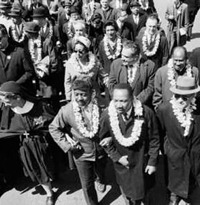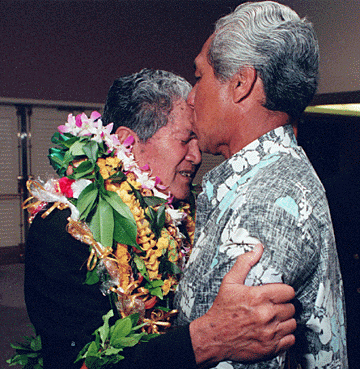Human Flower Project
Kahu: Leis for the March from Selma
On the holiday to remember Martin Luther King, we honor a Hawaiian civil rights leader, too, and his floral gift to the historic march on Montgomery.
 Martin Luther King and marchers
Martin Luther King and marchers
March ‘65, on the way
to Montgomery, AL
Photo: via Hoover
In late February 1965 Jimmy Lee Jackson, a teenager in Perry County, Alabama, was shot and killed by a state trooper during a peaceful demonstration in the courthouse square. The black community there came together in outrage and dedication; they decided to take their grievances over segregation and police violence to the statehouse in Montgomery. When Gov. George Wallace forbade their demonstration, Martin Luther King, Jr. traveled to Washington, D.C., appealing to President Lyndon Johnson for support. Meanwhile, the activists began their march out of Selma…
“When the marchers reached the city line, they found a posse of state troopers waiting for them. As the demonstrators crossed the bridge leading out of Selma, they were ordered to disperse, but the troopers did not wait for their warning to be heeded. They immediately attacked the crowd of people who had bowed their heads in prayer. Using tear gas and batons, the troopers chased the demonstrators to a black housing project, where they continued to beat the demonstrators as well as residents of the project who had not been at the march.”
Bloody Sunday, March 7, drew the nation’s attention like never before to the civil rights struggle. Returning to Alabama, King led a symbolic march to the bridge two days later. And on March 25th, a third march began. King and some 3200 others walked east out of Selma, twelve miles a day, sleeping in fields. They arrived in Montgomery five days later, and before a crowd of 25,000, King spoke:
I know you are asking today, ‘“How long will it take?” Somebody’s asking, “How long will prejudice blind the visions of men, darken their understanding, and drive bright-eyed wisdom from her sacred throne?” …How long will justice be crucified, and truth bear it? I come to say to you this afternoon, however difficult the moment, however frustrating the hour, it will not be long, because “truth crushed to earth will rise again.” How long? Not long, because “no lie can live forever.” How long? Not long, because “you shall reap what you sow.”
Muddy fields and tear gas, aching feet and billy clubs, what part do flowers have in the brave Selma marches?
We found startling pictures yesterday of King and others somewhere along the route from Selma to Montgomery. They’re festooned with glorious white leis!
 Rev. Abraham Akaka
Rev. Abraham Akaka
receives a kiss on his 75th birthday from Danny Kaleikini (1992)
Photo: Star Bulletin
These were gifts from Reverend Dr. Abraham Akaka, better known in his native Hawaii as ‘Kahu’ (shepherd). Akaka was the pastor of Kawaiahao Church, the ‘Mother Church’ of Hawaii, for nearly 30 years. He was also the state’s first commissioner for civil rights. When King came to the islands in 1964 to celebrate Civil Rights Week, they met at the University of Hawaii, beginning what was to become a close friendship. That following spring, Kahu lent his support to the courageous marchers out of Selma by adorning them with flowers.
Though we had never heard of him, Rev. Akaka was a giant in his homeland, “the most influential and widely known Hawaiian since Kamehameha the Great. Newsweek once described him as having the ‘charm of a beachboy and the force of a Billy Graham.’” In 1962, both Hawaii’s candidates for governor asked “Kahu” to run with them, for lieutenant governor. He turned them both down. “I’m a bridge between the Republicans and Democrats,” Akaka said. No doubt the clash at Selma’s Edmund Pettis Bridge on Bloody Sunday incited him and inspired this gift.
We don’t pretend to fathom the meaning of the lei in Hawaiian culture. Meanings is more like it, since there are ceremonial garlands of many kinds, each with flowers, seeds, feathers, and shells selected for their special beauty and spirit-power. We hope that lei experts will be able to decode for us the symbolism of these particular objects. And we would be MOST interested to learn if a local Selma florist had the fortitude to make them! How did they get here and around the necks of the marchers?

Selma Civil Rights March: March 21, 1965. From left: U.S. Representative John Lewis (D-GA), an unidentified nun; Ralph Abernathy; Martin Luther King, Jr.; Ralph Bunche, Rabbi Abraham Joshua Heschel, Rev. F.D. Reese wearing leis sent by Abraham Akaka.
Photo: Susannah Heschel
We can be fairly certain that Kahu’s leis were to bring the civil rights marchers protection and honor. Further, leis carry with them a spirit of peace: They “were given to ali’i (royalty) as a sign of affection and when two warring chiefs settled their differences, they wove a lei which meant an end to the hostilities.” Did Rev. Akaka send a lei to Wallace, too?
In a society that fixates on individual personality and prowess, we in the U.S. mark “Martin Luther King Day.” But one pedestrian doesn’t make a march, or one flower a lei. Many thousands of others, like Jimmy Lee Jackson and Reverend Akaka have led, followed, flowered, and died in this struggle. With respectful thanks, we celebrate them all.


Thanks for the beautiful (and new to me) story. Happy holiday.